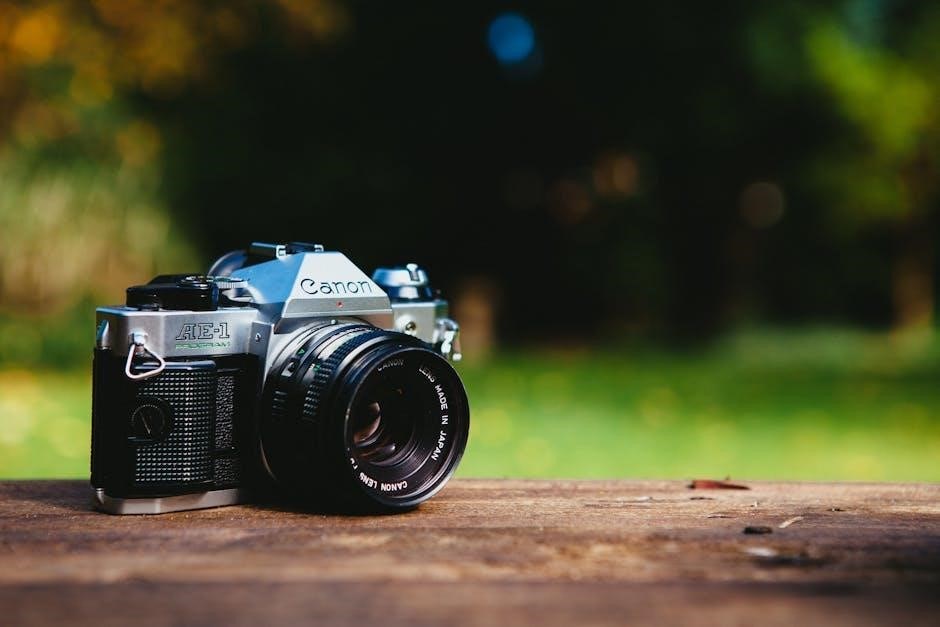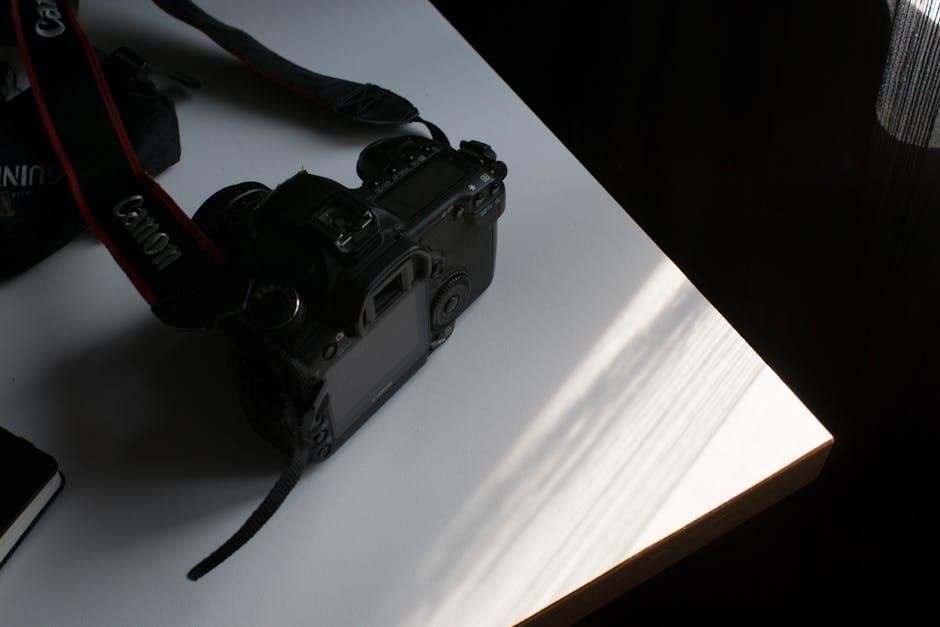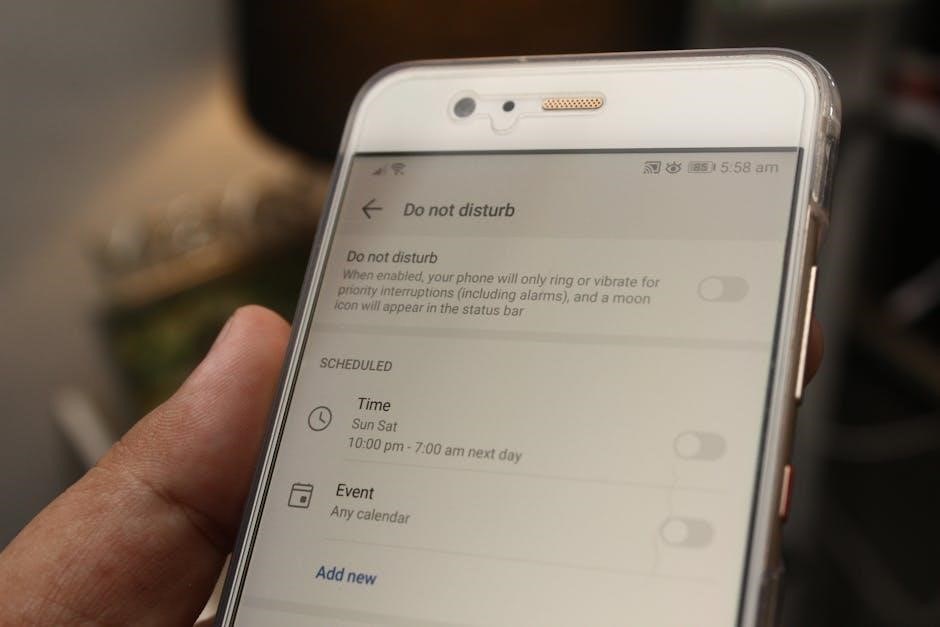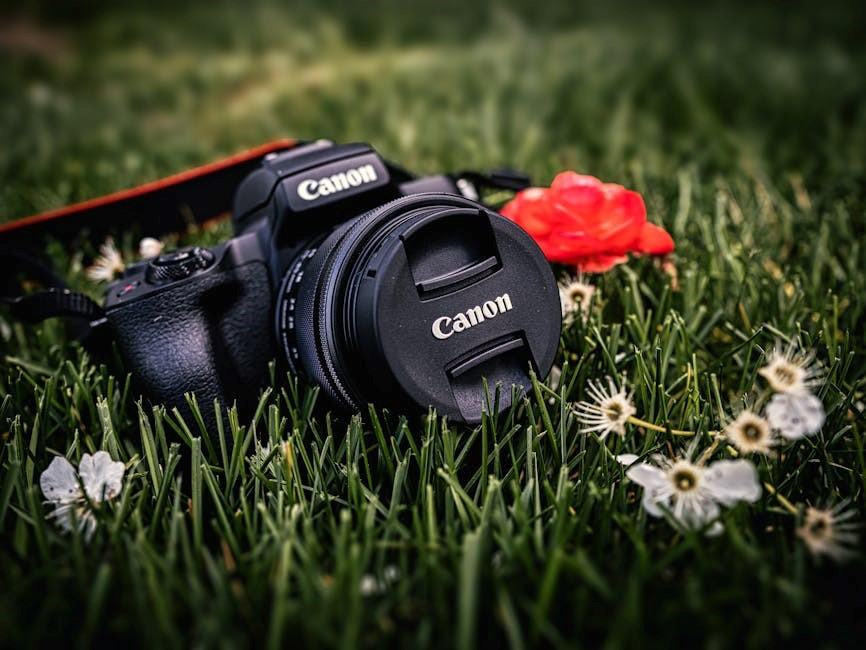
canon ae 1 program user manual
Overview of the Canon AE-1 Program Camera
Welcome to the Canon AE-1 Program user manual. This guide helps you master the camera’s features, including Programmed AE, aperture, and shutter priority modes, plus troubleshooting and maintenance tips.
The Canon AE-1 Program is an advanced 35mm SLR film camera introduced in 1981, designed for both amateur and professional photographers. It features a built-in microprocessor for precise exposure calculations, offering Programmed AE, Shutter-Speed Priority, Aperture Priority, and manual override modes. The camera supports Canon FD lenses, providing versatility for various shooting scenarios. Its durable design and user-friendly interface make it a popular choice for film photography enthusiasts. The AE-1 Program includes features like automatic film advance, self-timer, and compatibility with external flash units. With its robust build quality and intuitive controls, the camera remains a favorite among collectors and photographers seeking a reliable analog shooting experience. This manual provides detailed guidance on operating and maintaining the AE-1 Program, ensuring optimal performance and creative control over your photography.
Importance of Reading the User Manual
Reading the Canon AE-1 Program user manual is essential to fully understand and utilize the camera’s advanced features, ensuring optimal performance and creative control. The manual provides detailed explanations of exposure modes, such as Programmed AE, Shutter-Speed Priority, and Aperture Priority, as well as manual override options. It also covers lens compatibility, maintenance tips, and troubleshooting common issues. By understanding the camera’s capabilities and proper usage, photographers can avoid errors and achieve consistent, high-quality results. The manual serves as a comprehensive guide for both beginners and experienced users, helping them master the AE-1 Program’s unique functions and enhance their photography skills. Taking the time to read and follow the manual ensures that you get the most out of your camera, whether you’re shooting in automatic or manual modes.

Key Features of the Canon AE-1 Program
The Canon AE-1 Program offers advanced features like Programmed AE, Shutter-Speed Priority, Aperture Priority, and Manual Override modes, ensuring versatility for photographers of all skill levels, enhancing creative control and image quality.
Programmed AE Mode
The Programmed AE Mode on the Canon AE-1 Program offers automatic exposure control, allowing photographers to capture images with minimal effort. This mode uses the camera’s CPU to automatically adjust both aperture and shutter speed for optimal exposure. It is ideal for situations where quick adjustments are needed, such as street photography or candid shots. The mode works seamlessly with Canon FD lenses set to the A mark, ensuring compatibility and precise control. Users can rely on the Programmed AE Mode for balanced exposures, while still having the option to override settings manually if desired. This feature is particularly beneficial for beginners, as it simplifies the photography process while producing high-quality results. The mode also supports ISO settings from 25 to 3200, providing flexibility in various lighting conditions. Overall, the Programmed AE Mode strikes a perfect balance between convenience and creative control.
Shutter-Speed Priority AE Mode
The Shutter-Speed Priority AE Mode on the Canon AE-1 Program allows photographers to manually set the desired shutter speed, while the camera automatically adjusts the aperture for optimal exposure. This mode is ideal for capturing moving subjects, freezing action, or creating artistic effects like motion blur. Users can select shutter speeds ranging from 1/1000th of a second to 8 seconds, providing precise control over the image’s temporal aspects. The camera’s CPU ensures accurate aperture adjustments based on the selected shutter speed, maintaining proper exposure. This mode is particularly useful for sports, wildlife, and low-light photography. When using FD lenses set to the A mark, the camera seamlessly integrates with the shutter-speed priority mode, offering consistent results. The Shutter-Speed Priority AE Mode balances creative control with automatic precision, making it a versatile tool for photographers of all skill levels.

Aperture Priority AE Mode
The Aperture Priority AE Mode on the Canon AE-1 Program offers photographers precise control over the lens aperture, while the camera automatically adjusts the shutter speed for optimal exposure. This mode is perfect for situations where depth of field is critical, such as portrait photography, where a shallow depth of field isolates subjects, or landscape photography, where a large depth of field ensures sharpness throughout the image. By manually selecting the aperture, users can achieve creative effects like bokeh or sharp focus from foreground to background. The camera’s CPU ensures that the shutter speed is adjusted accurately to maintain proper exposure, making this mode both flexible and user-friendly. Aperture Priority AE Mode is particularly beneficial for photographers who prioritize depth of field in their compositions, allowing for artistic control while relying on the camera’s automation for technical precision. This mode is fully compatible with Canon FD lenses, enhancing the overall shooting experience with consistent and reliable results.
Manual Override Option
The Manual Override Option on the Canon AE-1 Program allows photographers to bypass automatic settings and take full control of exposure. This feature is ideal for experienced users who prefer precise control over aperture, shutter speed, and exposure compensation. By switching from Programmed AE to manual mode, photographers can manually adjust both the aperture ring and the shutter speed dial to achieve the desired exposure. The camera’s built-in light meter provides accurate exposure readings, enabling users to fine-tune their settings for optimal results. This option is particularly useful in challenging lighting conditions or when specific artistic effects are desired. However, manual operation requires a solid understanding of photography fundamentals, such as the relationship between aperture, shutter speed, and exposure compensation. The Manual Override Option enhances the AE-1 Program’s versatility, making it a powerful tool for creative expression.

Exposure Modes and Settings
The Canon AE-1 Program offers multiple exposure modes, including Programmed AE, Shutter-Speed Priority, and Aperture Priority, allowing automatic or manual control over exposure settings for precise results.
Understanding Programmed AE Mode
The Programmed AE mode on the Canon AE-1 Program is an automatic exposure mode that simplifies photography by allowing the camera to set both the aperture and shutter speed automatically. This mode is ideal for beginners or those who want to focus on composition without worrying about technical settings. The camera’s CPU analyzes the scene and selects optimal exposure parameters, ensuring balanced results in various lighting conditions. While in Programmed AE, users can still adjust exposure compensation to fine-tune brightness. The mode is versatile, working seamlessly with Canon FD lenses, and automatically switches to 1/60 sec shutter speed and auto aperture when an FD lens is set to the A mark. This mode strikes a perfect balance between convenience and creativity, making it a favorite for both casual and professional photographers. It’s a great starting point for mastering the camera’s capabilities.
Shutter-Speed Priority AE Mode Explained
The Shutter-Speed Priority AE mode on the Canon AE-1 Program allows photographers to manually set the desired shutter speed, while the camera automatically adjusts the aperture to achieve the optimal exposure. This mode is particularly useful for controlling motion effects, such as freezing fast-moving subjects or creating artistic blur. To use this mode, simply rotate the mode dial to the TV (Shutter-Speed Priority) position and adjust the shutter speed using the dial. The camera will then calculate the appropriate aperture based on the selected shutter speed and the lighting conditions. This mode is ideal for creative control over motion and is compatible with Canon FD lenses. Additionally, exposure compensation can be applied to fine-tune the results, offering flexibility for various shooting scenarios. This mode is a powerful tool for photographers who want to prioritize motion capture in their images.
Aperture Priority AE Mode Details
Aperture Priority AE mode on the Canon AE-1 Program grants photographers precise control over the lens aperture, allowing for creative depth-of-field effects. By setting the desired aperture, the camera automatically adjusts the shutter speed to ensure optimal exposure. This mode is ideal for portraits, where a wide aperture can blur the background, or for landscapes, where a narrow aperture ensures sharp focus throughout. To activate this mode, set the mode dial to the AV (Aperture Value) position and adjust the aperture using the lens aperture ring. The camera will then calculate the appropriate shutter speed based on the selected aperture and lighting conditions. This mode is particularly effective when using Canon FD lenses, as they offer a wide range of aperture settings. Additionally, exposure compensation can be applied to refine the results, providing greater flexibility for achieving the desired visual effect in various shooting situations. This mode is a valuable asset for photographers seeking control over depth of field and image aesthetics;
Using AE Flash Mode
AE Flash mode on the Canon AE-1 Program combines automatic flash exposure with manual control, ensuring well-balanced lighting in your images. To activate this mode, set the mode dial to the AE Flash position and attach a compatible Canon Speedlite or flash unit. The camera will automatically adjust the aperture and shutter speed to optimize flash exposure, while also allowing manual overrides for creative control. This mode is particularly useful for capturing sharp, evenly lit subjects in low-light conditions or for adding depth to backlit scenes. When using AE Flash, the shutter speed is typically set to 1/60th of a second, and the aperture is adjusted based on the flash output. For best results, use Canon FD lenses and ensure the flash is properly synced with the camera. This feature is ideal for photographers seeking versatility in flash photography while maintaining precise control over their shots.

Lens Compatibility and Accessories
Canon FD Lens Compatibility
The Canon AE-1 Program is fully compatible with Canon FD-mount lenses, offering a wide range of focal lengths and aperture settings for versatile photography. The FD lenses ensure optimal performance and image quality, making them ideal for both casual and professional use. Additionally, the camera supports manual focusing, allowing precise control over your shots. Accessories like the Canon Speedlite flash units and original straps further enhance functionality and convenience. With FD lenses, you can achieve sharp, high-quality images effortlessly, making the AE-1 Program a reliable choice for photographers of all levels. The compatibility with FD lenses ensures that you can explore various creative possibilities while maintaining the camera’s performance and reliability.
The Canon AE-1 Program is designed to work seamlessly with Canon FD-mount lenses, ensuring optimal performance and image quality. These lenses are renowned for their optical excellence and durability, making them a perfect match for the camera. The FD lens series offers a wide range of focal lengths and aperture settings, catering to various photography needs, from portraits to landscapes. The camera’s manual focusing feature allows for precise control when using FD lenses, enabling photographers to achieve sharp and detailed images. Additionally, the FD mount supports easy lens changes, making it convenient to switch between different lenses during a shoot. While third-party lenses can also be used with the FD mount, Canon’s own FD lenses provide the best integration and results. This compatibility ensures that the AE-1 Program remains a versatile and reliable tool for both professional and enthusiast photographers.
Recommended Accessories for the AE-1 Program
To enhance your photography experience with the Canon AE-1 Program, several accessories are highly recommended. The Canon FD lenses are the primary choice, offering exceptional optical quality and versatility for various shooting scenarios. A sturdy neck strap ensures comfortable handling during extended use. For lens care, a high-quality cleaning kit is essential to maintain clarity and prevent damage. Additionally, a remote shutter release or cable helps minimize camera shake for sharper images. Flash units, such as the Canon Speedlites, expand your creative options in low-light conditions. Lastly, a protective camera bag or case is vital for safeguarding your equipment during travel. These accessories not only enhance functionality but also protect your investment, making the AE-1 Program a reliable and adaptable tool for photographers of all skill levels.

Using the Program Mode Effectively
The Canon AE-1 Program excels in its automatic modes, allowing seamless switching between Programmed AE, aperture, and shutter priority for optimal results in various lighting conditions, ensuring versatility and ease of use.

Setting Up the Camera for Programmed AE
To set up the Canon AE-1 Program for Programmed AE mode, ensure the lens is set to the “A” position and the film is loaded correctly. Turn the mode dial to “Programmed AE” for automatic exposure settings. The camera will adjust both aperture and shutter speed based on the lighting conditions. This mode is ideal for beginners or those seeking convenience, as it simplifies the shooting process while delivering consistent results. For more control, you can override the settings manually by adjusting the aperture or shutter speed dials. Always refer to the manual for specific instructions on fine-tuning your shots and troubleshooting common issues. Proper setup ensures optimal performance, making the AE-1 Program a versatile tool for capturing high-quality images effortlessly.
Switching Between Exposure Modes
The Canon AE-1 Program offers seamless mode switching to cater to various shooting scenarios. To switch between exposure modes, locate the mode dial on top of the camera. Turn the dial to select from Programmed AE, Shutter-Speed Priority AE, Aperture Priority AE, or Manual Override. In Programmed AE, the camera automatically adjusts both aperture and shutter speed for optimal exposure. Shutter-Speed Priority AE allows you to set the shutter speed, with the camera adjusting the aperture accordingly. Aperture Priority AE lets you control the aperture, while the camera sets the shutter speed. For full control, Manual Override enables you to adjust both settings independently. This flexibility ensures you can adapt to different lighting conditions and creative preferences, making the AE-1 Program a versatile and user-friendly camera for photographers of all levels. Always refer to the manual for detailed instructions on mode switching and customization.

Maintenance and Troubleshooting
Regularly clean the lens and camera body to prevent dust buildup. Check battery levels and ensure proper film loading. For common issues, consult the manual for troubleshooting guides.
Cleaning and Maintaining the Camera

Regular maintenance is essential to ensure the Canon AE-1 Program functions optimally. Use a soft, dry cloth to wipe the camera body and lens, avoiding harsh chemicals or abrasive materials. For the lens, a microfiber cloth and lens cleaning solution can be used to remove smudges and fingerprints. The viewfinder should also be cleaned regularly to maintain clarity. Additionally, check the battery compartment for corrosion and ensure the film compartment is free from dust. Proper handling and storage will extend the camera’s lifespan. Always refer to the manual for detailed cleaning instructions and troubleshooting tips to address common issues promptly.
By following these maintenance steps, you can keep your Canon AE-1 Program in excellent condition and ensure it continues to deliver high-quality results for years to come.
Common Issues and Solutions
While the Canon AE-1 Program is a reliable camera, some common issues may arise. One frequent problem is inaccurate exposure readings, often due to battery weakness. Replacing the batteries with fresh ones typically resolves this. Another issue is the camera not firing, which could be caused by improper film loading or a faulty shutter. Ensure the film is loaded correctly and the shutter is functioning. If the lens is not focusing properly, clean the contacts between the lens and camera body. Additionally, if the flash does not sync, check the flash settings and ensure it is compatible with the camera. For persistent issues, refer to the troubleshooting section in the manual or consult a professional. Regular maintenance and proper usage can prevent many of these problems, ensuring your camera operates smoothly.
The Canon AE-1 Program is a timeless camera offering versatile modes and durability. Mastering it enhances your photography experience. Explore resources for further learning and troubleshooting to maximize its potential.
Mastering the Canon AE-1 Program
Mastering the Canon AE-1 Program requires understanding its exposure modes and features. Start by familiarizing yourself with Programmed AE, shutter-speed priority, and aperture priority modes. Practice using manual override for creative control. Experiment with different FD lenses to explore varying focal lengths and effects. Regularly clean and maintain the camera to ensure optimal performance. Refer to the user manual for troubleshooting common issues and optimizing settings. Explore additional resources, such as online tutorials and photography guides, to deepen your skills. With consistent practice and exploration, you can unlock the full potential of the AE-1 Program and achieve professional-quality results in film photography;
Resources for Further Learning

To deepen your understanding of the Canon AE-1 Program, explore official Canon resources, including the downloadable PDF manual. Online forums and photography communities offer valuable insights and troubleshooting tips. Websites like LensInc.net provide detailed guides and tutorials. Additionally, YouTube channels and blogs dedicated to film photography often feature the AE-1 Program, showcasing its capabilities. For hands-on learning, consider enrolling in photography workshops or courses that focus on manual cameras. Books on film photography techniques can also enhance your skills. Finally, join social media groups and forums where enthusiasts share their experiences and tips for using the AE-1 Program effectively. These resources will help you master the camera and unlock its full creative potential.